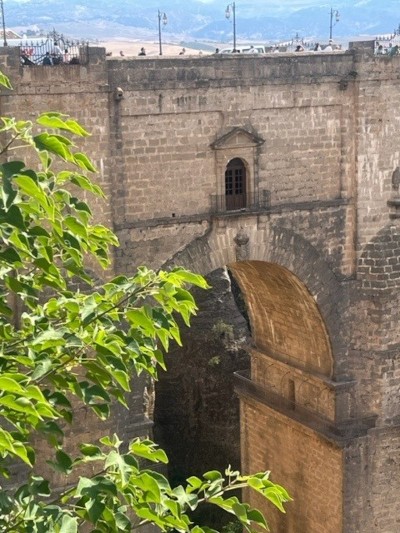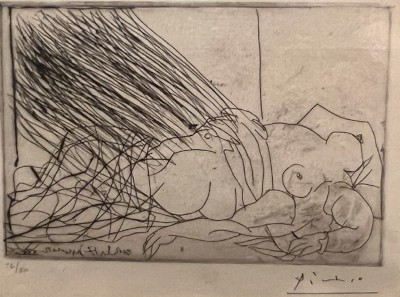Ronda
In October 2023 we visited Ronda from Casa Mijas, one of the most beautiful cities in Andalusia. We drove there via Marbella, a beautiful mountain road and the way back via Coin, this road it is considerably flatter and easier to drive.
In Ronda we parked in the first parking garage we came across. We then visited the Tourist Information point and bought a ticket to visit six interesting sights.
We visited: Puente Nuevo, Convento de Santo Domingo, Casa del Gigante, Museo Joaquín Peinado, Palacio Mondragón and LosBanos Árabes.
A piece of history: Ronda is inhabited by different peoples. Celts, Phoenicians, Greeks and Moors once made Ronda their home. During the Moorish occupation, Ronda was even declared the capital of the Andalusia region.
 Puente Nuevo: Ronda is known for its beautiful bridges. There are three bridges that bridge the Tajo de Ronda, a tens of meters deep gorge that divides Ronda in two: the Ciudad Vella (the old town) and the Mercado (the market). At some points this gorge is more than a hundred meters deep. The Puente Nuevo (New Bridge) is an impressive structure with a height of 89 meters. It took 40 years to build the bridge. By entering the city via this bridge, you have already seen one of the most famous buildings in Spain upon entering.
Puente Nuevo: Ronda is known for its beautiful bridges. There are three bridges that bridge the Tajo de Ronda, a tens of meters deep gorge that divides Ronda in two: the Ciudad Vella (the old town) and the Mercado (the market). At some points this gorge is more than a hundred meters deep. The Puente Nuevo (New Bridge) is an impressive structure with a height of 89 meters. It took 40 years to build the bridge. By entering the city via this bridge, you have already seen one of the most famous buildings in Spain upon entering.
Convento de Santo Domingo: The Convento de Santo Domingo is a monastery in Ronda, the monastery is located directly on the famous bridge and was founded in 1485 immediately after the conquest of the Spanish Christian kings from the Moors in Ronda. Today the monastery is used as a conference center.
Casa del Gigante: The Giant's House. The name of this house has its origins in two statues carved in stone that decorated the corners of the building. There is now only one left, its origin is Phoenician. Casa del Gigante is considered one of the best preserved palaces of Nazari architecture. It is a Moorish structure of a living area surrounding a central patio. Here you will also find remains of Nazari decorations that are of such high quality that you can only find them in the Alhambra in Granada. A sign of how important Ronda must have been in the time of the Moors.
 Museo Joaguin Peinado: This was a really beautiful museum. It is located in the former Palace of Mocetzuma. It is a real pleasure to walk around the beautiful building and admire the beautiful works of art by Joaquín Peinado, Ronden painter. Joaquín was a friend of Picasso. You will also find some works by Picasso here. An absolute tip for art and architecture lovers.
Museo Joaguin Peinado: This was a really beautiful museum. It is located in the former Palace of Mocetzuma. It is a real pleasure to walk around the beautiful building and admire the beautiful works of art by Joaquín Peinado, Ronden painter. Joaquín was a friend of Picasso. You will also find some works by Picasso here. An absolute tip for art and architecture lovers.
Palacio Mondragon: The name Palacio de Mondragón is very well known in Ronda. But its other name Palacio del Marqués de Villasierra (once a very important resident of Ronda), is less known. Anyway, this palace is Ronda's most important monument (besides the bridge and the arena), for historical and architectural reasons.
Los baños árabes de Ronda: The Arab Baths of Ronda are bathhouses from the period of Almohad rule. They are the best preserved baths in all of Spain. Here you can also get a good insight into Moorish life during the 13th to the 16th century.
The outer walls of the Arab baths have remained largely intact, the Saqiya (water pump tower) still stands, as does the aqueduct. On top of the Saqiya stood a donkey that turned a wheel that pumped water from the river via the aqueduct to the baths. A deep shaft had been made in the center of the tower that went down to the river. In the tower there were two large wheels connected to a large belt on which terracotta pots were attached that transported the water upwards. Upstairs, these pots were emptied into a gutter that led the water via the aqueduct to the baths.
We thought it was really worthwhile to visit this beautiful city.



